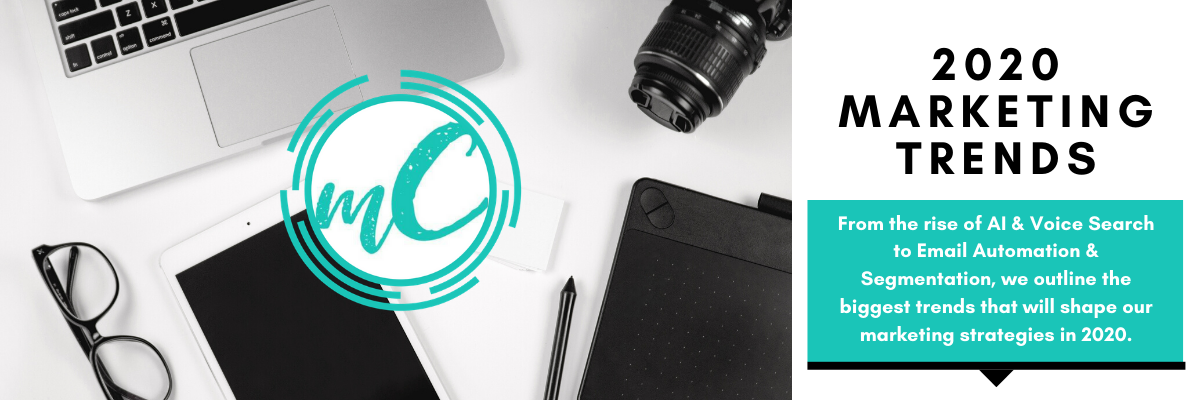
A new year always feels like a great time to hit the reset button. That is until we turn the page on the calendar and already start to feel behind!
Whether you’re working on building your personal brand, drawing an updated business development blueprint for your business, or even still trying to tackle that marketing to-do list from 2019 — our team is here for you. We put together a list of top marketing trends for 2020. Pick the trends that resonate most for you, and create a plan to take steps toward your goals.
INFOGRAPHIC MORE YOUR STYLE? SKIP AHEAD AND DOWNLOAD IT NOW!
Conversational Marketing
Just as authenticity was a major buzzword in 2019, expect to see the word conversational start to pop up in 2020. With a shift toward authentic, original, and real marketing, we saw brands work to incorporate the human element into campaigns. The idea of a “one size fits all” cookie-cutter approach is no longer reliable when it comes to how we communicate with our clients and customers. Businesses that want to increase their success must make the mindset shift to see people as people, instead of people as clicks. In the same way that you would market your business in a face-to-face discussion, that’s the way we need to approach the up-and-coming trend of conversational marketing.

Conversational marketing is all about establishing relationships and fostering authentic engagement with your clients, without asking them to fill out lengthy forms or waiting days for a response. There are two main components to a successful conversational marketing strategy: the first is to reflect your thorough understanding of your customers and their needs through targeted messaging. The creation of buyer personas and keyword research are two important tools to writing content that feels personal, and creates a connection with your audience.
The second component is real-time engagement and response, through live chat. Today’s consumers are conditioned to look for information quickly: 42% of people expect an immediate response (within 5 seconds), and 36% expect a response within 5 minutes (Drift.com). A robust conversational marketing strategy will allow you to stay on top of the unique and ever-changing needs of your customers.
The size of your company may not allow for 1:1 interaction 24/7, and that’s okay! When used right, intelligent chatbots are a great solution for businesses that want to offer quick and simple communication between their company and their clients. Jump to our Emerging Technology section to learn more about how we can expect to see voice search, AI, and VR trending in 2020.
Community Marketing
With the establishment of social media networks, brands have pivoted away from advertising that simply sells to customers, opting to move instead toward marketing that encourages interaction. This shift has become known as community marketing and it’s going to be an interesting emerging trend for some brands to capitalize on in 2020.

Community marketing is not about just simply getting new customers, it’s about connecting and engaging with existing customers, to the point where they become so loyal that they are authentic brand ambassadors.
Community marketing is about the conversation. Yes, there’s that word again! It’s about engagement with natural conversation. A community is there to serve the customers, not sell to them. A brand that has done community marketing right creates a community rather than a following.
The question then becomes, how can a business build a community? Building an authentic, engaged, and loyal community starts with knowing your audience. You need to have a strong grasp on who your target demographic is, what they want, and what’s important to them. Once you know that, you can begin building a community using:
- Facebook and LinkedIn groups
- One-on-one interactions
- Facebook events
- Instagram stories that use polls and questions
Let’s take a look at an example. A health supplement company is new to the market but they know their product works. They build a Facebook Group and invite everyone who purchases their product to join the group. Those who join the group probably have a lot in common, mainly a health problem they are trying to solve. Because the group is private, they can talk freely about their health problems with others who share their experiences. In this group, the company can see their existing customer’s pain points, answer their questions, and address any concerns. Consumers also gain trust for the company and its products by interacting with other customers. In this way, consumers rely on real-time reviews while also interacting with and creating additional content. What will these customers do? They will recommend the product to others, share stories of their own challenges and solutions, and effectively begin to build the community. Start thinking like this, and you’ll rock 2020.
Content Marketing: Personalized and Interactive Content
“Content is king.” It’s the adage of marketing because it’s true! New technology trends are redefining every aspect of digital content—more than 90 percent of buyers are looking for a new online experience that delivers engaging and personalized digital content, which is exactly what 2020 will bring.

Instead of reading an article, watching a video, or listening to a podcast, interactive content requires your audience to actually engage in the messaging that you’re delivering. Interactive content is meant to educate visitors and keep them engaged for a longer period of time, which then gives you the opportunity to capture a potential client’s personalized results and gather feedback about their user experience.
This content is dynamic, so there are various ways it can be created:
- 360 video
- Galleries
- Calculators
- Assessments, polls, and surveys
- Contests and bracket competitions
- Infographics and interactive white papers
Since this kind of content is so easily sharable, it reaches a broader audience, drives web traffic, and raises brand awareness. You can use it as a blog post, on your landing page, in an email, on social media pages, or as a paid media ad. It can also be integrated into any e-commerce web platform or content management system (CMS).
We know consumers want more interactivity, but what makes them want to engage with this content? Personalization. Consumers want interactive content tailored to their individual set of needs, wants, and goals versus generic ads or the exact same collection of content sent to every other customer—in fact, 72% of consumers in 2019 said they only engage with marketing messages customized to their specific interests.
Personalized, interactive content is the best way to connect with your audience in a meaningful way across digital platforms. If it’s not already, it should be a key component in your 2020 marketing strategy.
Social Media Marketing: Interactive Ads & Shopping
Social media marketing is offering more ways to gather customers, promote products, and increase sales. Today’s audiences expect easy, interactive options for online shopping, with shareable content that leads to heightened brand awareness. E-commerce within Facebook and Instagram — without leaving the platforms — now allows greater variety, like clickable links to direct products, along with new formats of marketing that turn viewers into active participants. Two of the top marketing trends for 2020 include interactive advertisements and shopping on platforms.
Interactive Advertisements on Social Media

Flat, traditional advertisements are passive and are quickly becoming outdated in the face of interactive advertisements. The newer and popular media promotes engagement through users responding to questions, finding products via QR codes, taking quizzes, and more. It allows a company to seek brand differentiation and optimize your positioning within the industry.
Immersive ads are becoming both necessary and clever for businesses that are aware of how mobile use increases and user attention span decreases. Creativity is essential to attract and retain customers. Additional ways to harness interactive advertisements have been shown through virtual and augmented reality.
![]()
Shopping on Social Media Platforms
Facebook and Instagram are making it easier and preferable for users to be able to shop without ever leaving their social media platforms. Surveys have shown that 72% of Instagram users have purchased a product on the app, while 70% of Pinterest users find new uses and products that they click through to. Their e-commerce platforms make shopping products or services more convenient and effective, so companies that sell through them can enhance their business for increased profitability. It benefits marketers by simplifying the selling process for customers and offers another reason to optimize and promote your mobile site.
Social Media Stories
Throughout 2019, we talked about the growing importance of “stories” on Facebook and Instagram. In the coming year, this medium will be a great way to create interactive content with your audience.

Stories are snippets that create a feed of sequential content that disappears after 24 hours. A story can be a static image, a boomerang, or a video. You can add stickers, hashtags, overlays, location tags and more. With more than 400 million people use Instagram Stories daily, it gives you the opportunity to get your brand in front of consumers who are likely to engage with your content. New features like music, polls, and questions all make engagement easy.
To really embrace the story feature on both Facebook and Instagram, here are few suggestions on the types of content to share:
- Polls (get your followers involved by asking questions and getting their input)
- Behind the scenes content
- Shared user content
- Time-sensitive deals and promos
Remember, this content disappears after 24 hours so you want to make the most of it by using bright colors, making text easy to read, and encouraging interaction.
Social Influencer Marketing
As 2019 ends, we’re on the cusp of one of the biggest changes to date with the Instagram algorithm, as the likes disappear. A lot of people are wondering how this is going to change strategy for marketers, especially those using brand ambassadors and social media influencers.

Likes aren’t completely going away. You will still be able to view the like count on your own photos and videos — you just won’t be able to see the total likes on other public content. Instagram says this is about, “creating a less pressurized environment where people feel comfortable expressing themselves.” According to Wired Magazine, Instagram’s CEO says he cares more about users than making money, so they are making decisions that help people’s well-being and mental health. This move comes after a 2017 study found Instagram was the worst social network for mental health, linking it to depression and anxiety.
Facebook has also experimented with getting rid of likes and Twitter has hinted at it, so this could be a trend that we see take hold in 2020.
Emerging Technology
The shift to a more conversational tone in digital marketing strategies was strongly influenced by the rise of voice search, and we saw a takeoff in the use of AI like Hey Google, Alexa, and Siri in 2019 that surprised even the experts. By the coming year, more than 50% of all online searches will be done by voice, which means that for consumer-facing brands, mastering a conversational tone in your marketing efforts will be key. To stay on top of the voice technology trend, think about keywords and phrases that people will speak, rather than type, and incorporate this approach into the way you write copy for your website and advertisements.

The rise of AI is going to give companies and brands an opportunity to target new audiences, particularly if they’re using 2020 to implement AI into their marketing for the first time. Intelligent chatbots are a significant part of emerging technology, particularly within a strong conversational marketing strategy. The use of chatbots on your website lets you engage with your audience anytime they want to engage with you. AI can also allow brands to automate certain required tasks, allowing for more time spent on strategic efforts and less time on rote or repetitive projects.
Augmented and virtual reality will also be on the rise in 2020. Companies like IKEA have gotten in on the ground floor of this trend, with tools like an app that allows you to see what a piece of furniture might look like in your home before purchasing it. While that is a large-scale example, brands and businesses of all sizes should be asking themselves how they can use these emerging technologies to cultivate relationships with and inspire confidence in current and future customers.
Email Marketing
If Sheryl Sandburg had predicted the top marketing trends for 2020, email marketing would not have been on her list. In 2010, she famously announced the end of email. It seemed to make sense. With the rise of social media and other platforms, teenagers were not using email like their parents were. So, many people predicted that when Gen Z entered the workforce, technology would shift and email would die. Only… it didn’t. In fact, it has continued to grow.

Reports show that checking email is the #1 activity on the internet with 94% of internet users getting online for this reason alone. That actually surpasses social media usage and online searches, which are also top activities.
Some buzzwords we’ve been using for email marketing include automation, segmentation, and personalization. Now, we add to the list: user-generated content, interactivity, and accessibility.
Automation: while there will always be a place for one-off emails, alerts, and newsletters, automation rules email. An automatic email campaign is set up once and then automatically sent to a particular individual when that person meets a certain trigger. This can include simple welcome emails, thank yous, asking for reviews, reminders — anything that can be set up with a trigger, like a date, website click, or another piece of data.
Segmentation: is when you break down your email subscribers into smaller segments based on specific criteria. Typically, segmentation is used as a personalization tactic to deliver more relevant email marketing to subscribers based on their geographic location, interests, purchase history, and more. Segments are created so that you can cater specifically to each different email list and that list’s independent interests, rather than creating one mass message for all.
Personalization: takes this a step further by creating a seemingly one-on-one experience, even when targeting users through automation and segmentation. This is a broad term, but our numbers show that the more personal you get, the better your return. This is because people are seen as people instead of just clicks. Instead of receiving a campaign with generic offers and messaging, your subscribers will receive an email that is targeted directly at them, with their name and offers that are relevant to their interests.
 User-Generated Content: is just what it sounds like: any form of content (text, images, audio and visual) created by the product’s end-user. Use your email campaigns to collect this content. Ask for reviews, send polls and surveys. Find ways to incentivize your client to contribute content to directly help your conversion. E-commerce platform, 3dcart says that 82% of consumers consider user-generated reviews extremely valuable and 70% of all consumers will look to reviews or ratings before making a purchasing decision. We also know that email subscribers are 3x more likely to share content on social media, so email marketing works in tandem with social media when creating UGC.
User-Generated Content: is just what it sounds like: any form of content (text, images, audio and visual) created by the product’s end-user. Use your email campaigns to collect this content. Ask for reviews, send polls and surveys. Find ways to incentivize your client to contribute content to directly help your conversion. E-commerce platform, 3dcart says that 82% of consumers consider user-generated reviews extremely valuable and 70% of all consumers will look to reviews or ratings before making a purchasing decision. We also know that email subscribers are 3x more likely to share content on social media, so email marketing works in tandem with social media when creating UGC.
Interactivity: 2020 could be the first year that more emails are opened on a mobile device than a desktop or laptop environment. Given that ⅔ of mobile users will delete your email if it’s not optimized, emails must be responsive in design. Keep this in mind when designing emails to be interactive. Animated buttons, calls-to-action, rollover effects, interactive image and product carousels are some key elements.
Accessibility: Having a strong code-base behind your email is the best way to assure accessibility. Make sure you use alt text for all images, so screen readers can read them for the visually impaired. Voice search also skyrocketed even more than expected in 2019, so this is another reason to optimize your email campaigns for accessibility. This is a trend that is not slowing down anytime soon. Roughly 250 million smart speakers are expected to be installed worldwide by the end of the year, so big brands are already designing with accessibility in mind.
Read more on email marketing trends in our full article on Email Marketing Trends for 2020.
Video Trends

A picture is worth a thousand words, so how many words is a video worth? Priceless! At least, as far as the algorithms for Google and social media are concerned. Video is an invaluable digital marketing tool that is becoming prevalent and popular for savvy businesses to utilize. Companies can promote their products or services with demonstrations on how they work, unique uses or offerings, and putting employee faces in front of the camera.
Two new video platforms are offering new marketing options for 2020, making you and your company the star of your own show.
Facebook Watch
This popular option is a video-on-demand service that’s available as a specific app or through TV streaming. Videos are categorized through Editor’s Picks, Top Picks, Search, and Watchlist. Viewers can save videos and follow their favorite people or pages. Facebook Watch works to specialize in original content and collaborations with actors and influencers. The content is shareable and driven by social media collaborations.
IGTV

Instagram has changed the visual playing field with their newest platform, IGTV. It’s a stand-alone video application for smartphones, offering a more modern and mobile experience. For those people who have dreamed of being able to host their own shows, now you can! Anyone on Instagram can create their own unique channel, and use it to build their brand, gather viewers, and promote their stories. The videos are able to be recorded or viewed horizontally and vertically. For viewers, Instagram curates specific video recommendations for you, based on the accounts you follow and your interests. Notifications will alert you when a new video has been posted by someone you follow.
Live streaming videos remain a top trend. They add a hint of drama and excitement that a recorded version lacks, and come across as more interesting and interactive. In fact, live videos keep your audience watching three times longer than recorded ones, which is why live videos are important in various algorithms.
SEO: Zero Position
Number one used to be the top position in search engine optimization, but changes in SEO have made a new spot to aim for: position zero. Position zero is a featured snippet that aims to directly answer users’ questions, without needing to click the search result link. It’s the first Google search result that appears above organic SEO listings. If your market needs answers to frequently asked questions, you should be aiming to rank in position zero.

What does a position zero featured snippet look like? By Googling the simple question, the snippet appears, and is in paragraph form for the best response for this individual query. It answers the question in a block of content, recommended to be between 40 and 60 words. Additional display options include lists (ideal for answering questions that require steps, like how do I make pumpkin pie?), and tables (used for cooking conversions measurements, for example).
Position zero provides informative, convenient, and quick answers to a query. The responding content is explicit and in-depth, but remains concise. Users don’t have to search for content or go through websites, since the information immediately appears. Despite that, position zero has been shown to vastly improve stats, including visits, click-throughs, and conversions. In fact, acquiring a featured snippet led to a 516% increase in sessions.
Position zero is extremely valuable, and it’s attainable! In order to rank for it, know the questions your audience is asking and their search keywords. Anticipate the queries, answer them directly, and see how position zero optimizes your SEO and your business.
Project Management + Company Organization
A business trend that is continuing to grow at full speed is outsourcing – specifically for operational and administrative needs. More companies are discovering the benefit of contracting out for internal support, rather than hiring a team of employees to fill the roles, or provide the necessary professional training.
The benefits of outsourcing can be substantial. For many companies, it’s a cost-saver. Outsourcing work to an individual or company that specializes in that specific field – on an as-needed basis – can keep expenses lower than hiring a full-time employee, or team of employees. We see this especially with administrative duties such as making phone calls, managing calendars, coordinating travel for company staff, and various other tasks that would traditionally be performed by an internal administrative or executive assistant. And oftentimes contractors work remotely, so in addition to not needing to pay benefits, you’re also saving on overhead expenses.

In other instances, there’s already an employee that can do the necessary work, but they need guidance and support to be able to provide the best service. This is when it might make sense to hire a consultant who can provide the training needed so the employees can work more productively and efficiently.
We’re seeing outsourcing needs come up with our own clients at mConnexions. Stephanie Barnhill, our Operations Manager and Consultant, shares her experience working with clients who look to outsourcing for additional organizational support:
“Business owners do it all – build and grow their companies by providing their product or service, while also taking on the marketing and sales roles, and handling all the company’s financial, operational, and administrative needs. But burning the candle at both ends isn’t sustainable. I’ve found that with even a little boost of operational and administrative support through contracting or consulting, business owners are able to refocus on what they do best, while still building a solid foundation with good internal policy and protocol. Typically we work on finding and filling the gaps – which can be employee hiring, training and onboarding; creating policy documentation; overseeing workflow and company protocol, or simply helping the team get organized. When a strong foundation is in place, the employees are doing what they do best, and operations are streamlined and efficient, the company is well on its way to promoting healthy growth and happy people.”
KEEP ALL OF THIS INFORMATION HANDY WITH A FREE 2020 MARKETING TRENDS INFOGRAPHIC
LATEST BLOGS & RESOURCES
From A to Z: The Power of Fonts in Branding and Design
We see words around us all day, every day - on billboards and street signs and storefronts, on our computers, [...]
Out with the Old: The Anti-Trends Shaping Your 2024 Marketing Game Plan
Near the end of every year, our team puts our heads together and takes a close look at marketing trends [...]
It’s time to unwrap our 2024 Marketing Trends!
It’s the most wonderful time of the year: time for our look ahead to the upcoming marketing trends of the [...]
10 Lessons I’ve Learned Since Being Named One of Lansing’s “10 Over the Next Ten”
The room was buzzing. More hugs than handshakes were being exchanged among some of Lansing's brightest minds—a testament to relationships [...]




